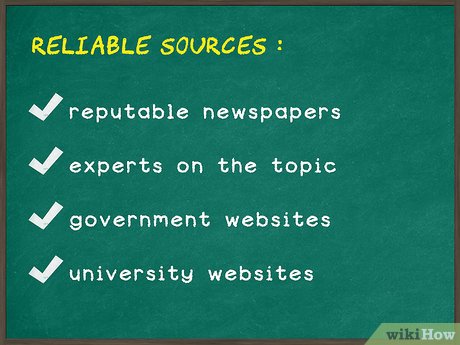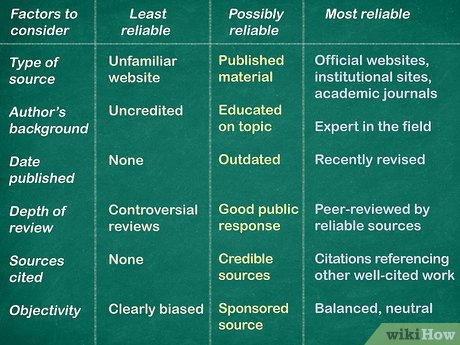Whether you are a student or a professional, you may need to conduct academic research. Strong research involves accessing and evaluating various forms of information. You then analyze the information you find to answer a question or come to a conclusion about an issue. Once your research is complete, you’ll present your findings, typically in a research paper or a presentation.X
StepsPart 1Part 1 of 3:Defining Your Research Question
1Determine a broad topic for your research. If you’re doing research for a class project, you’ll likely already have a broad topic provided by the class. Likewise, if you’re doing research for work, your supervisor may indicate what they want you to look into. For example, if you’re taking a history course on Europe in World War II, the title of the course may be your broad topic. Your instructor might limit your topic further, such as asking you to focus on France.
2Explore the broad topic to find a potential question. Within the broad topic of your project, think about a more specific thing you’d like to know, or question you’d like to answer. Depending on the context of your research, you may need approval from an instructor or supervisor.For example, you may decide you want to research the activities of the French Resistance in aiding the Allies during World War II. A potential research question might be “How did the French Resistance provide intelligence to the Allies?”Some instructors may provide a list of research questions, or other information to help you narrow your topic. If you want to deviate from the list, talk to your instructor about your interests.
3Conduct an initial search to test your question. Search online or use library databases to get a general idea of how much information is out there about your research question before you commit to it. If you get a lot of results back, you may want to narrow your question. If you have a hard time finding anything, you may need to broaden your scope.Identify key words to search, and try different combinations to fully test your question. For example, if you are researching the French Resistance during World War II, you might do a search for “French Resistance intelligence” and another for “French assistance Allies.”If you find articles or books that address your research question exactly, choose a different question. You might review the article or book you find to see if it mentions additional questions that still haven’t been answered.
4Reevaluate your research question based on what you’ve learned. After your test searches, look at your research question again. Decide whether your original research question is actually in line with the scope of your project. If it isn’t, you may need to expand or narrow your focus.XIf you’re writing a research paper, consider its length. Generally, a shorter paper should cover a narrower topic. Make sure you have enough sources available.Part 2Part 2 of 3:Finding Research Sources
1Use non-academic sources as a starting point. Books, as well as newspaper and magazine articles, can increase your familiarity with your topic. They may also introduce you to academic sources and experts whose work you can seek out.XDocumentary films can also serve as good introductory sources.You won’t necessarily be referencing any of these sources in your project, you’re simply using them to get a better feel for your topic, the experts in the field, and the sources available.
2Identify locations of likely sources. Based on your preliminary research, determine what kind of sources are most likely to have information that will help you answer your research question. In most cases, you’ll use a mixture of books, scholarly articles, and online sources.XTrustworthy SourcePurdue Online Writing LabTrusted resource for writing and citation guidelinesGo to sourceFor example, if you’re researching history, your likely sources will be published books and scholarly articles by historians. If you’re researching the development of smart phones, on the other hand, you’ll probably find most of your sources online or in tech magazines.You may need to use a university or specialty library, which likely has resources that aren’t available at libraries open to the general public. Contact the library you want to use to find out how you can gain access.
3Search for books and scholarly articles. Published books and scholarly articles are typically preferred sources for academic research. Retrieving sources typically involves making a trip to the library. You may be able to use the catalogue on the library’s website to request titles before you go.XDepending on your topic, it may be possible to do all of your research online. This is likely if you’re researching something trendy or cutting edge, such as a new tech development.Many scholarly articles can be found in electronic databases. University libraries typically allow free access to these databases for students and faculty.
4Get a research librarian to assist you. Research librarians are specifically trained to find sources of information. They can help locate books, articles, and other sources of information that you may not have been able to find on your own.XIn the library, look for the desk called the “research desk” or “reference desk.” These desks are often towards the back of the library. You can ask at the main desk or circulation desk if you aren’t sure where to go.Tell the research librarian your research question, and let them know what sources you’ve found so far, as well as what types of sources you’re looking for. They may have additional sources or different search terms to suggest.
5Keep organized notes on each of your sources. Get a stack of index cards to use for notes. For each source, write the author’s name and the title on one side of the index card. On the other side, make a note of any information related to your research question.XIf you read material that you want to quote, write the quote exactly on a note card, then write the page number where that quote can be found. This will differentiate quotes from other notes.It can also help to write a key word that identifies the issue the notes on the card relate to, so you can organize cards related to different sections of your paper as you go. This way you’ll be able to tell at a glance if there’s a part of your paper that needs more sources or information.
6Synthesize your information and tie up loose ends. As you approach the end of your research, you may find areas that you need to explore further. Try to fill in any gaps in understanding that you have. Any further research you need to do at this point shouldn’t be too involved.XIf your research raises additional questions that are outside the scope of your project, you could simply acknowledge that they exist and would require further research.
7Craft your thesis statement based on what you’ve found. Your thesis statement is essentially the answer to your research question, our the conclusion that you’ve come to as a result of your research.XYour thesis statement makes a claim, or takes a position, and tells your readers why your position is important.For example, if you’re writing a paper about the French Resistance in World War II for a history class, your thesis statement might be “By providing intelligence to the Allies, sabotaging German efforts, and rescuing Allied pilots whose planes were shot down, the French resistance weakened the Nazi regime.”Part 3Part 3 of 3:Evaluating Your Sources
1Identify what type of source you’re using. Sources may be primary or secondary. Primary sources are original material, while secondary sources interpret, evaluate, or collect information from primary sources. For most academic research, primary sources are preferred over secondary sources.XIf you have a secondary source, look in the footnotes or bibliographies to get information about the original source. The citation should allow you to find the primary source and evaluate it yourself.You may need to use a secondary source if the primary source is not available to you. For example, if you read an article in which a book is quoted, you would want to find the quoted book if at all possible. However, if the book was published a long time ago and is out of print, you may have no choice but to use the secondary source.
2Review the credentials of the author or producer of the source. In most cases, the author of a source you’re using for academic research will be a professor in the field. If they aren’t a professor, look at their background and experience to determine whether they should be considered an expert.XFor science or tech topics, professionals working in the field are often just as reliable as professors or other academic experts.If you find the author’s name mentioned by other sources, that often means they are respected in the field. If other professionals have relied on their work, that’s a good sign that you can rely on it as well.
3Check the year the source was published. Generally, you want your research to include the most up-to-date information. If a source was published 5 or 10 years ago, the information may be outdated. For research in more cutting edge or rapidly developing fields, information may be outdated after a year or less.XWhether the year of publication affects the reliability of the information depends on your overall topic. For example, if you’re conducting research on ancient Greek philosophy, the date of publication wouldn’t necessarily matter. However, if you were conducting research on social media and voting, you would want to use sources published within the last year.
4Assess the reputation of the publisher of the source. Books and journals typically are published by a university press or other academic publisher. You might also find books published by mainstream publishing companies, such as Penguin or Random House.XBe wary of small, independent presses or self-published books. They don’t have robust fact-checking and editing like larger, established presses do.Reputation is particularly important for online sources. Search for reviews or complaints about websites to find out if people in the field consider it to be a good source of information. You can also ask your instructor or supervisor if you’re not sure.
5Consider the reliability of online sources. Your reader should be able to find the sources you used in your research. Find out how long a website has been online, whether it is attached to an established institution, and the likelihood the website will remain online.XFor example, a website run by a university history department would likely be considered a reliable online source.








